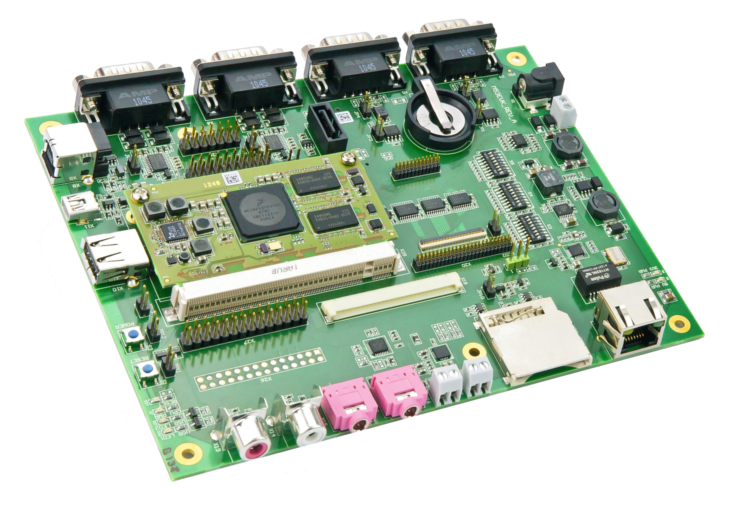Filter products
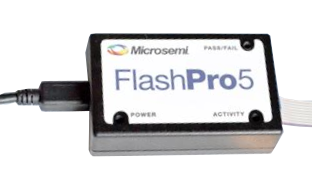
FlashPro5 is the programmer, which along with Windows, supports Linux platforms also such as RedHat Enterprise Linux 6 and CentOS 6, in conjunction with FlashPro Express software. It supports all FPGA devices in PolarFire, SmartFusion2, IGLOO2, RTG4, SmartFusion, Fusion, IGLOO, ProASIC3 and RT ProASIC3 seriesThe minimum version requirements to run FlashPro5, on Windows and Linux, are Libero SoC, Libero SoC PolarFire v1.1 or FlashPro v11.4.Key Features Supports in-system programming Supports IEEE 1149 JTAG programming through STAPL Supports USB 2.0 available
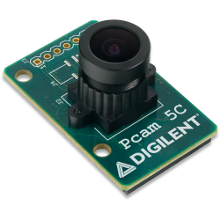
The Pcam 5C is an imaging module meant for use with FPGA development boards. The module is designed around the Omnivision OV5640 5 megapixel (MP) color image sensor. This sensor includes various internal processing functions that can improve image quality, including automatic white balance, automatic black level calibration, and controls for adjusting saturation, hue, gamma and sharpness. Data is transferred over a dual-lane MIPI CSI-2 interface, which provides enough data bandwidth to support common video streaming formats such as 1080p (at 30 frames per second) and 720p (at 60 frames per second). The module is connected to the FPGA development board via a 15-pin flat-flexible cable (FFC) that is pin compatible with the connector found on the popular Raspberry Pi development board. The Pcam 5C comes with a 10 cm flat-flexible cable and a factory-installed fixed focus lens with M12 lens mount, so it is ready to use out of the box. Features: 5MP color system-on-chip image sensor 15-pin FFC connector for image data Dual lane MIPI CSI-2 image sensor interface Supports QSXGA@15Hz, 1080p@30Hz, 720p@60Hz, VGA@90Hz and QVGA@120Hz Output formats include RAW10, RGB565, CCIR656, YUV422/420, YCbCr422, and JPEG compression* Standard M12 lens mount for lens interchangeability Ships with 10 cm cable and factory installed fixed-focus lens Small PCB size for flexible designs (4.0 cm x 2.5 cm) 1×7 straight 100-mil header for access to auxiliary camera signals Works with Pcam compatible Digilent development boards *JPEG compressed output is a feature of the OV5640, but is currently untested on this module
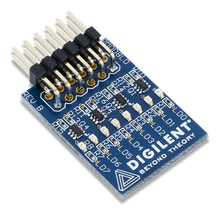
Features: Eight high-brightness green LEDs; Uses BJTs for low-power logic level control; Small PCB size for flexible designs 2.8 cm × 2.0 cm; 2×6-pin Pmod connector with GPIO interface. Pmod 8LD has eight high-brightness LEDs that are driven by logic level transistors so that each LED can be individually illuminated from a logic high signal. Custom antistatic Pmod packaging is included.
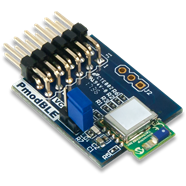
The Digilent Pmod BLE is a powerful peripheral module meant for use with any UART enabled development board. This Pmod employs the Roving Networks RN4870 to create a fully integrated Bluetooth Low Energy interface. This chip features an onboard Bluetooth stack that makes connecting and communicating with any Bluetooth 4.X device possible through simple UART commands. The RN4870 also features four built-in GATT services: Device Information, Airpatch, BeaconThings, and UART Transparent data streaming. It also allows up to five custom public services and up to four custom private services, each allowing up to eight custom characteristics. The Pmod BLE is an affordable, versatile, low energy addition to the wireless Pmod library. Features: Bluetooth® Smart 4.2 BLE compatible Add wireless capability with low power Bluetooth radio ASCII command interface over UART UART transparent service for serial data streaming Secure communications, 128-bit AES encryption, and white list capabilities Customizable GAP, GATT, SM, L2CAP, and integrated public profiles 12-pin Pmod port with UART interface
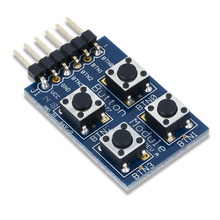
Features: Four momentary pushbuttons; Debouncing filters; Inverting Schmitt Triggers; Small PCB size for flexible designs 3.0 cm × 2.0 cm; 6-pin Pmod connector with GPIO interface. Pmod BTN gives users four momentary pushbuttons for easy user inputs to a system board. Custom antistatic Pmod packaging is included.
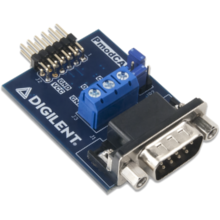
The Pmod CAN is a CAN 2.0B controller with an integrated transceiver. The embedded Microchip MCP25625 chip connects directly to the physical CAN bus and meets automotive requirements for high-speed (1 Mb/s), low quiescent current, electromagnetic compatibility, and electrostatic discharge. Features: CAN 2.0B controller with integrated transceiver Suitable for automotive applications Up to 1 Mb/s operation Up to 10 MHz SPI clock speed Standard DB9 connector for secure connection Small PCB size for flexible designs 1.4" × 1.8" (3.6 cm × 4.6 cm) 12-pin Pmod connector with SPI interface Follows the Digilent Pmod Interface Specification 1.1.0 type 2A Libraries and example code available in resource center
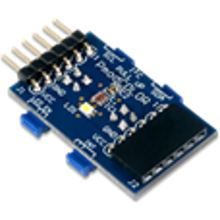
The Digilent Pmod COLOR is a color sensor module with the ability to sense red, green, blue and clear light. The onboard AMS's TCS3472 integrates an IR blocking filter to accurately determine the color of objects as well as sense ambient light under varying lighting conditions and through attenuating materials. Features: IR-blocking filter White LED for reflective measurements Suitable for use behind darkened glass Small PCB size for flexible designs 0.8“ × 1.35” (2.03 cm × 3.43 cm) 6-pin Pmod connector with I²C interface Pass-through Pmod host port for daisy chaining Follows Digilent Pmod Interface Specification Type 6 Library and example code available on the Resource Center

Features: Rotary push-button shaft encoder; Add multiple types of user input to host board or project; Additional static slide switch; Small PCB size for flexible designs 3.8 cm × 2.0 cm; 6-pin Pmod connector with GPIO interface. Pmod ENC features a rotary shaft encoder with an integral push-button to provide multiple types of outputs such as a way for users to quickly switch between multiple choices shown on a screen or predefined motor speeds. The module also includes a sliding switch that is commonly used as an on/off output. An encoder is commonly used in freely rotating volume knobs to detect how many "clicks" a knob has been rotated. Custom antistatic Pmod packaging is included.
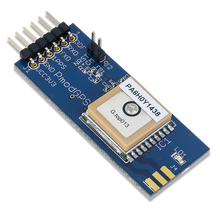
Features: Ultra-sensitive GPS module (-165 dBm); Add 3m 2D satellite positioning accuracy to any embedded system; Low power consumption; Up to 10Hz update rate; NMEA (default) and RTCM protocols available; Small PCB size for flexible designs 5.0 cm × 2.0 cm; 6-pin Pmod connector with UART interface. Pmod GPS can provide satellite positioning accuracy to any embedded system. By communicating through UART with the GlobalTop FGPMMOPA6H GPS module, users may benefit from the 3 meter accuracy for any long term traveling. Custom antistatic Pmod packaging is included.
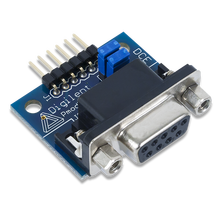
Features: Maxim Integrated MAX3232 RS232 transceiver; Standard RS232 DB9 connector; Optional RTS and CTS handshaking functions; Small PCB size for flexible designs 2.5 cm × 3.3 cm; 6-pin Pmod connector with UART interface. Pmod RS232 converts between digital logic voltage levels to RS232 voltage levels using the Maxim Integrated MAX3232 transceiver. The RS232 module is configured as a data communications equipment (DCE) device. It connects to data terminal equipment (DTE) devices, such as the serial port on a PC, using a straight-through cable. Custom antistatic Pmod packaging is included.
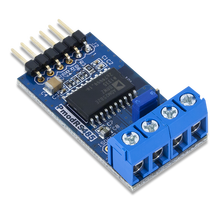
Features: High-speed RS-485 communication module; Isolated RS-485/RS-422 interfaces for use in noisy environments; 16Mbps maximum data rate; Connect up to 256 nodes on one bus; Differential half or full-duplex communication; Thermal shutdown and ±15kV ESD protection; 6-pin Pmod connector with UART interface. Pmod RS485 is a high-speed communication module powered by the Analog Devices ADM582E. By communicating with the device via UART, users can take advantage of the RS485 communication protocol with speeds up to 16 Mbps. Custom antistatic Pmod packaging is included.
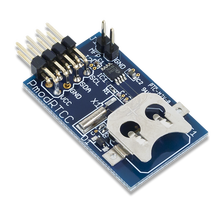
Features: Real-time clock/calendar with lithium coin cell back-up; Multi-function pin output that can generate a square wave; Two available alarms; 128 bytes EEPROM; 64 bytes SRAM; Small PCB size for flexible designs 3.3 cm × 2.0 cm; 2×4-pin connector with I2C interface. Pmod RTCC is a real-time clock/calendar powered by the Microchip MCP79410. Through the I2C interface, users may configure up to two alarms that can be triggered at a wide variety of possible times. Custom antistatic Pmod packaging is included.
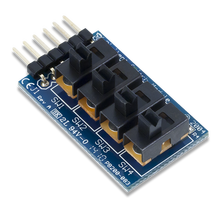
Features: 4 slide switches; Add user input to host board or project; Static binary logic input; Small PCB size for flexible designs 3.3 cm × 2.0 cm; 6-pin Pmod connector with GPIO interface. Pmod SWT provides users with four slides switches for up to 16 different binary logic inputs to for the attached system board. Custom antistatic Pmod packaging is included.

Features: USB to serial UART interface; Micro USB connector; Option to power the system board through the FTDI chip; Small PCB size for flexible designs 2.5 cm × 2.0 cm; 6-pin Pmod connector with UART interface. Pmod USBUART provides a USB to UART cross-conversion through the FTDI FT232R. Users may send data in either direction on the Pmod and receive the converted data in the appropriate format. Custom antistatic Pmod packaging is included.

